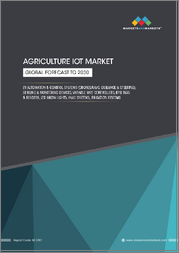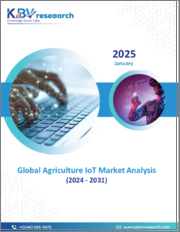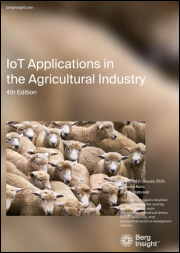
|
시장보고서
상품코드
1565799
아시아태평양의 농업 IoT 시장 : 용도별, 제품별, 국가별 - 분석 및 예측(2023-2033년)Asia-Pacific IoT in Agriculture Market: Focus on Application, Product, and Country - Analysis and Forecast, 2023-2033 |
||||||
아시아태평양의 농업 IoT 시장 규모는 2023년 46억 3,000만 달러에 달할 것으로 예상됩니다.
이 시장은 2033년 186억 4,000만 달러에 달할 것으로 예측됩니다. 사물인터넷(IoT)은 농업 공정의 관리 및 최적화에 있어 획기적인 발전을 의미하기 때문에 아시아태평양(APAC) 농업 부문에 매우 중요합니다. IoT 기술을 도입함으로써 농부들과 농업 관련 기업들은 날씨, 작물의 건강 상태, 토양 수분 및 기타 중요한 요소들을 추적하는 센서로부터 다양한 실시간 데이터에 접근할 수 있게 되었습니다. 고급 분석을 통해 이 데이터를 면밀히 분석하여 농약, 비료, 물 사용으로 인한 환경적 악영향을 최소화하면서 품질과 생산량을 개선하고 비용을 절감하는 정밀 농법을 지원할 수 있습니다.
또한, IoT 기술은 인력 부족 문제를 완화하고 심기 및 수확을 포함한 다양한 농업 작업을 자동화하여 생산량을 늘리는 데 도움이 될 수 있습니다. 농업 IoT의 통합은 지속가능성과 효율성을 향상시키고 보다 스마트하고 효과적인 기술을 장려함으로써 식량 안보에 기여하며, APAC 지역이 계속 발전함에 따라 농업 IoT의 도입은 혁신과 성장의 큰 기회를 가져와 보다 탄력적이고 생산적인 농업 환경을 보장합니다.
| 주요 시장 통계 | |
|---|---|
| 예측 기간 | 2023-2033년 |
| 2023년 평가 | 46억 3,000만 달러 |
| 2033년 전망 | 186억 4,000만 달러 |
| CAGR | 14.93% |
농업의 생산성과 효율성 향상에 대한 수요가 아시아태평양(APAC) 농업 IoT 시장의 괄목할 만한 성장을 주도하고 있습니다. 이 지역의 급속한 인구 증가와 식량 수요 증가에 따라 농부들은 사물인터넷(IoT) 기술에 의존하여 작업을 간소화하고 지속 가능한 관행을 보장하기 위해 노력하고 있습니다.
센서, 연결 장치와 같은 IoT 기술을 통해 농부들은 작물의 건강 상태, 토양 수분, 날씨, 가축 모니터링 등 다양한 요소에 대한 실시간 정보에 접근할 수 있게 됩니다. 이 데이터를 통해 정밀 농업이 가능해져 자원 낭비를 최소화하면서 작물 수확량을 늘리는 집중적인 행동을 할 수 있게 됩니다. 농부들은 첨단 분석을 통해 농약, 비료, 물의 사용량을 최적화하고 정보에 입각한 의사결정을 내림으로써 환경에 미치는 영향을 최소화할 수 있습니다.
또한, IoT 기술은 관개, 심기, 수확과 같은 절차를 자동화함으로써 농업의 노동력 위기를 극복하는 데 도움을 줄 수 있습니다. 스마트 농업과 기술 개선을 지원하는 정부 정책은 농업 분야에서 사물인터넷(IoT)의 확장을 촉진하고 있으며, 이 분야는 계속해서 디지털 혁신을 받아들이고 있습니다.
일반적으로 아시아태평양의 농업용 IoT 시장은 세계 문제 변화에 직면하여 식량 안보, 지속가능성 및 농업 생산을 개선하는 최첨단 솔루션을 제공함으로써 크게 성장할 것으로 예상됩니다.
이 보고서는 아시아태평양의 농업 IoT 시장을 조사했으며, 시장 개요와 함께 용도별, 제품별, 국가별 동향, 시장 진출기업 프로파일 등의 정보를 제공합니다.
목차
주요 요약
제1장 시장
- 동향 : 현재 및 향후 영향 평가
- 공급망 분석
- 연구개발 리뷰
- 규제 상황
- 시장 역학 개요
제2장 지역
- 지역별 개요
- 성장 촉진요인과 억제요인
- 아시아태평양
제3장 시장 - 경쟁 벤치마킹과 기업 개요
- 향후 전망
- 지역적 평가
- Eruvaka Technologies
제4장 조사 방법
LSH 24.10.14Introduction to Asia-Pacific IoT in Agriculture Market
The Asia-Pacific IoT in the agriculture market was valued at $4.63 billion in 2023 and is expected to reach $18.64 billion by 2033. The Internet of Things (IoT) is critical to the Asia-Pacific (APAC) agriculture sector because it represents a major breakthrough in the management and optimization of agricultural processes. Farmers and agribusinesses may access a variety of real-time data from sensors that track weather, crop health, soil moisture, and other important elements by implementing IoT technologies. With the use of advanced analytics, this data is examined to support precision farming methods that improve quality and production while cutting expenses and minimizing the negative effects of pesticide, fertilizer, and water usage on the environment.
In addition, IoT technology helps mitigate the manpower scarcity issue and increases output by automating a range of agricultural operations, including planting and harvesting. IoT integration in agriculture improves sustainability and efficiency and contributes to food security by encouraging smarter, more effective techniques. As the APAC region continues to develop, the implementation of IoT in agriculture presents significant opportunities for innovation and growth, ensuring a more resilient and productive agricultural landscape.
| KEY MARKET STATISTICS | |
|---|---|
| Forecast Period | 2023 - 2033 |
| 2023 Evaluation | $4.63 Billion |
| 2033 Forecast | $18.64 Billion |
| CAGR | 14.93% |
Market Introduction
The demand for increased productivity and efficiency in the agricultural industry is driving a notable expansion in the Asia-Pacific (APAC) IoT in agriculture market. Farmers are resorting to Internet of Things (IoT) technologies to streamline their operations and guarantee sustainable practices as a result of the region's rapid population growth and rising food demand.
IoT technologies, like sensors and linked devices, give farmers access to real-time information on a range of factors, such as crop health, soil moisture, weather, and livestock monitoring. Precision agriculture is made possible by this data, which permits focused actions that increase crop yields while minimizing resource waste. Farmers may minimize their influence on the environment by using advanced analytics to make well-informed decisions that optimize their usage of pesticides, fertilizers, and water.
Furthermore, by automating procedures like irrigation, planting, and harvesting, IoT technologies aid in addressing the labor crisis in agriculture. Government measures supporting smart farming and technical improvements are driving the expansion of the Internet of Things (IoT) in the agriculture sector, as the area continues to embrace digital transformation.
In general, the IoT for agriculture market in Asia-Pacific is expected to grow significantly, providing cutting-edge solutions that improve food security, sustainability, and agricultural production in the face of changing global issues.
Market Segmentation
Segmentation 1: by Application
- Precision Crop Farming
- Livestock Monitoring and Management
- Indoor Farming
- Aquaculture
- Others
Segmentation 2: by Component
- Hardware
- Processors and Sensors
- Communication Modules
- Others
- Software
Segmentation 3: by Country
- Japan
- India
- China
- Australia and New Zealand
- Indonesia
- Vietnam
- Malaysia
- Rest-of-Asia-Pacific
How can this report add value to an organization?
Product/Innovation Strategy: The product segment helps the reader understand the different types of components available for deployment and their potential in APAC region. Moreover, the study provides the reader with a detailed understanding of the APAC IoT in agriculture market by application on the basis of application (precision crop farming, livestock monitoring and management, indoor farming, aquaculture, and others) and product on the basis of component (hardware and software).
Growth/Marketing Strategy: The Asia-Pacific IoT in agriculture market has seen major development by key players operating in the market, such as business expansion, partnership, collaboration, and joint venture. The favored strategy for the companies has been partnerships and contracts to strengthen their position in the IoT in agriculture market.
Competitive Strategy: Key players in the Asia-Pacific IoT in agriculture market analyzed and profiled in the study involve major IoT in agriculture, offering companies providing IoT in agriculture for the purpose. Moreover, a detailed competitive benchmarking of the players operating in the IoT in agriculture market has been done to help the reader understand how players stack against each other, presenting a clear market landscape. Additionally, comprehensive competitive strategies such as partnerships, agreements, and collaborations will aid the reader in understanding the untapped revenue pockets in the market.
Table of Contents
Executive Summary
Scope and Definition
1 Markets
- 1.1 Trends: Current and Future Impact Assessment
- 1.1.1 Trends: Overview
- 1.1.2 Agricultural Drones
- 1.1.3 Autonomous Systems and Agricultural Robots
- 1.1.4 Blockchain for Traceability
- 1.2 Supply Chain Analysis
- 1.2.1 Value Chain Analysis
- 1.3 Research and Development Review
- 1.3.1 Patent Filing Trend (by Country, Number of Patents)
- 1.4 Regulatory Landscape
- 1.5 Market Dynamics Overview
- 1.5.1 Market Drivers
- 1.5.1.1 Increase in Demand for Agricultural Efficiency and Productivity
- 1.5.1.2 Advancements in Agricultural Technologies
- 1.5.1.3 Rise in Adoption of Precision Farming
- 1.5.2 Market Restraints
- 1.5.2.1 Lack of Trained Personnel
- 1.5.2.2 High Initial Investment Costs
- 1.5.3 Market Opportunities
- 1.5.3.1 Integration of IoT in Robotics
- 1.5.3.2 Livestock Monitoring and Management
- 1.5.1 Market Drivers
2 Regions
- 2.1 Regional Summary
- 2.2 Drivers and Restraints
- 2.3 Asia-Pacific
- 2.3.1 Regional Overview
- 2.3.2 Driving Factors for Market Growth
- 2.3.3 Factors Challenging the Market
- 2.3.4 Application
- 2.3.5 Product
- 2.3.6 China
- 2.3.7 Application
- 2.3.8 Product
- 2.3.9 India
- 2.3.10 Application
- 2.3.11 Product
- 2.3.12 Japan
- 2.3.13 Application
- 2.3.14 Product
- 2.3.15 Australia and New Zealand
- 2.3.16 Application
- 2.3.17 Product
- 2.3.18 Indonesia
- 2.3.19 Application
- 2.3.20 Product
- 2.3.21 Vietnam
- 2.3.22 Product
- 2.3.23 Product
- 2.3.24 Malaysia
- 2.3.25 Application
- 2.3.26 Product
- 2.3.27 Rest-of-Asia-Pacific
- 2.3.28 Product
3 Markets - Competitive Benchmarking & Company Profiles
- 3.1 Next Frontiers
- 3.2 Geographic Assessment
- 3.2.1 Eruvaka Technologies
- 3.2.1.1 Overview
- 3.2.1.2 Top Products/Product Portfolio
- 3.2.1.3 Top Competitors
- 3.2.1.4 Target Customers
- 3.2.1.5 Key Personnel
- 3.2.1.6 Analyst View
- 3.2.1.7 Market Share
- 3.2.1 Eruvaka Technologies
4 Research Methodology
- 4.1 Data Sources
- 4.1.1 Primary Data Sources
- 4.1.2 Secondary Data Sources
- 4.1.3 Data Triangulation
- 4.2 Market Estimation and Forecast



















